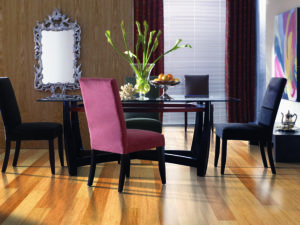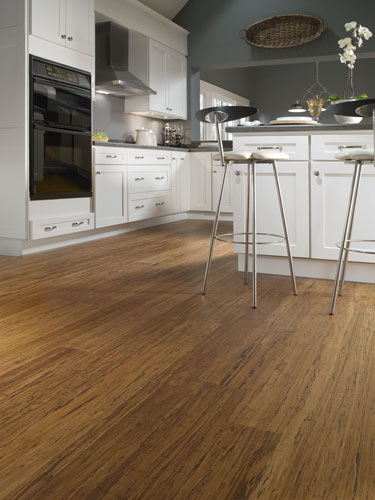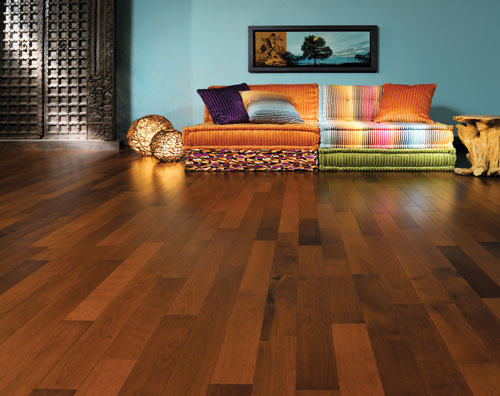 Environmentally friendly is a buzz phrase the flooring industry has seen become part of mainstream business conversation. Through research and development, focus groups and more, hardwood flooring executives have taken the temperature of the masses and have come to realize the importance of being green is great.
Environmentally friendly is a buzz phrase the flooring industry has seen become part of mainstream business conversation. Through research and development, focus groups and more, hardwood flooring executives have taken the temperature of the masses and have come to realize the importance of being green is great.
Accordingly, the products they manufacture are increasingly reflecting a consumer desire for a smaller carbon footprint and a conscious effort to be part of the environmentally responsible products for her home.
“One of our latest sustainable products is the introduction of strand woven bamboo,” according to Roger Farabee, Mohawk’s senior vice president of marketing. Because bamboo regenerates naturally and can be harvested every five to seven years, it is a LEED-recognized rapidly renewable resource.
“Our strand woven bamboo styles have been tested to be twice as hard as domestic oak, making them applicable for both residential and commercial applications,” he said. “Mohawk products are manufactured using all parts of the bamboo stalk for optimum green benefits, and they meet European E-1 Standards for low formaldehyde emissions. They can also contribute points to LEED certified projects.”
Hardwood mills are also increasingly offering cork flooring. “Cork is one of, if not the most, sustainable materials used for flooring,” said Gary Keeble, marketing manager for USFloors. It can be re-harvested every nine years over the course of a tree’s lifespan (250 to 300 years). And since only the bark of the cork oak tree is used, the tree is never cut down to make a floor.
“Because the harvest is not a technology-friendly operation, cork must be harvested by hand because of the delicate touch required. A machine would damage the heartwood of the tree. Nothing is wasted. Even the dust created for processing cork into flooring is used to fuel the factories making the floors.”
Cork has unique attributes that are carried from their natural state into finished flooring, such as the comfort and resilience that comes from its cell structure which creates millions of tiny pockets of air; thermal and acoustical insulation properties. The suberin substance created by cork oak as a natural defense mechanism provides the floor with a resistance to mold, mildew, household pests and even fire.
One of flooring’s newest and latest developments regarding these alternative products is the actual fusion of the two into one state-of-the-art offering.
As Keeble noted, “our most important innovation in the bamboo category has been our development of our Corboo product. Corboo is a hybrid strand woven bamboo and cork floor that infuses seams of cork into the strand woven bamboo. With our core business being cork and bamboo, it only seems natural to produce a floor that incorporates the two most sustainable materials in flooring.”
Traditional hardwood
Shiva Menon, product manager for Armstrong Hardwood, noted how the company’s introductions leverage innovation to preserve natural resources. “For example, our new Exotic Fusion is a collection of domestic exotic species that does not use stain. A special thermal treatment process caramelizes the wood, producing rich colors and distinctive grain effects similar to tropical exotics.”
Some Armstrong wood flooring products can be installed without an adhesive, but when one is needed, Armstrong specifies and supplies adhesives that meet strictest indoor air quality standards, Menon said. Those include the South Coast Air Quality Management District (SCAQMD) requirements for adhesives and sealants.
Some products like Bruce’s Lock&Fold American Exotics Hardwood don’t require any adhesive at all, he added. “Most engineered wood can be installed without adhesives using lock, staple and float techniques. Also, with pre-finished solid and engineered floors, no site finishing minimizes the amount of VOCs released into the home.”
According to Shaw’s hardwood category manager, Kevin Thompson, the mill’s Epic line represents the company’s latest environmentally responsible engineered hardwood. The product’s inner layer, EnviroCore, is made from post-industrial recycled content, making it one of the most sustainable engineered wood flooring products on the market. Epic styles use approximately 50% less newly harvested wood than conventional 3⁄8-inch engineered alternatives. Its core creates a more dimensionally stable platform, and due to its increased humidity resistance, Epic is suitable for virtually any climate and can be installed at any grade level—even below, where solid hardwoods present problems.
“All Epic products comply with the recently revised Lacey Act (FCNews, March 22/29),” Thompson said. “Additionally, the entire Epic collection is Cradle to Cradle Silver Certified by McDonough Braungart Design Chemistry (MBDC) and meets the stringent chemical emissions standards of the GreenGuard Children & School program.”
Boa-Franc, maker of the Mirage brand, also puts a premium on being green. “In recent years, Mirage has developed products that have real environmental benefits,” said Luc Robitaille, vice president of marketing. “For example, we obtained PEFC certification, which also contributes to sustainable forest management. Mirage ensures full compliance with the Lacey Act as well. What’s more, Mirage Lock is made of HDF that contains wood from 100% post-industrial recycled fibers, uses six times less hardwood than conventional wood flooring and fully complies with phase one of CARB 93120 certification.”
Robitaille added that Mirage’s Nanolinx finishes, including the new Nanolinx Premium designed for high-traffic and commercial areas, release no VOCs or formaldehyde. “Mirage also offers a variety of products that can help earn LEED credits.”
 He also cited Bali Coco, which can now be ordered under FSC Mixed Source certification. “The manufacturing process that we developed for Bali Coco brings out all the natural pigments of Canadian Breza, a local species, for an exotic look that doesn’t have to be shipped thousands of miles. All Mirage Lock and Mirage Engineered products in red oak, maple, and yellow birch are also eligible for FSC Mixed Source certification.”
He also cited Bali Coco, which can now be ordered under FSC Mixed Source certification. “The manufacturing process that we developed for Bali Coco brings out all the natural pigments of Canadian Breza, a local species, for an exotic look that doesn’t have to be shipped thousands of miles. All Mirage Lock and Mirage Engineered products in red oak, maple, and yellow birch are also eligible for FSC Mixed Source certification.”
Over the past two years, Mullican Flooring has focused on developing hardwood flooring that meets Leadership in Energy and Environmental Design (LEED) specifications for green builders, noted Brian Greenwell, vice president sales and marketing. “In 2009, we were the first hardwood floor manufacturer to introduce a solid domestic Forest Stewardship Council (FSC) 100% PURE floor, and currently we offer 30 products with this certification.” According to the FSC Chain of Custody (COC) standard, FSC PURE products are made entirely of wood or fiber originating from FSC-certified forests.
In terms of the mill’s manufacturing practices, Greenwell said, “We always maximize lumber use—by applying precision milling, advanced kiln-drying techniques and by using the most demanding inspectors in the business. This kind of no-waste approach applies to all phases of our operations. Bark removed from trees is used as mulch, wood chips are ground and used to generate heat for the drying process and to heat the plants in the winter. Sawdust, a byproduct of our manufacturing process, is packaged and sold to particleboard and decking manufacturers, while wood blocks are used to make charcoal, which ensures that no part of the tree is left for waste.”
At Mannington, when it comes to being environmentally friendly, the emphasis is on certification. “Most recently, our focus has been on certifying our supply chain through two methods,” said Dan Natkin, director of hardwood business. “First, our plants became FSC- COC certified last year, allowing us to begin producing FSC certified products, which we do on a project-by-project basis. We successfully went through our second year of the Chain of Custody audit earlier in 2010.
“Secondly, we became the third company to be certified under the NWFA RPP (responsible procurement program) this year,” he explained. “We continue to pursue meaningful certifications that help raise the bar for ‘doing the right thing’ when it comes to hardwood manufacturing.”
At Columbia Flooring, the mill this year launched a new scraped hardwood collection, Pagosa, produced using PureBond engineered flooring technology resulting in “no added formaldehyde.”
Columbia’s use of the patented PureBond technology was key to the manufacturer being the first in the industry to secure both the highly coveted FloorScore certification and CARB Phase 2 certification, earned almost one year ahead of the deadline, noted Dewevai Buchanan, vice president of hardwood.
“Distributors, retailers and consumers place value on the sustainability attributes of a product,” he explained. “All Columbia Flooring hardwood products are domestically manufactured using Appalachian grown timber (AHMI Verified Sustainable), which generates fewer greenhouse gas emissions in transport to retail when compared to imported [exotic] products.”
And at Anderson, being environmentally responsible has been part of the company’s culture since it’s inception. According to John Woolsey, vice president of marketing, the mill, a recent winner of the Hardwood Forestry Fund’s (HFF) Gifford Pinchot Award which recognizes significant corporate achievements in promoting sustainable forestry, has four legs that it’s been built on. “One is quality, one is styling and design, one is innovation and the other is stewardship, or environmental sensitivity. And unless it’s part of your culture, it’s just a means to an end.”
All Anderson hardwood flooring products are now GreenGuard Children & Schools certified, he noted, and are now listed on the GreenGuard Environmental Institute (GEI) website. The GreenGuard Children & Schools certification program recognizes companies whose products meet or exceed stringent requirements for low chemical emissions.
Due to the emphasis that the industry and country has placed for decades on being environmentally responsible, Woolsey said, the “good news today is that domestic hardwood forests are twice as full as they were 50 years ago. We have more forests than we did at the turn of the century.”
-Louis Iannaco
